Key
Word |
キーワード |
>Top
0. Introduction:
- How much does the new economy weigh?
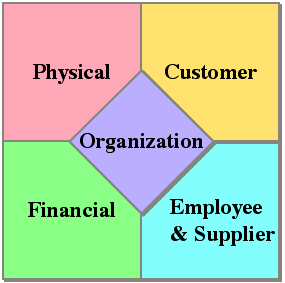
- "virtually unimaginable a half-century ago was the
extent to which concepts and ideas would substitute for replaces
physical resources and human brawn in the production of
goods and services." (Greenspan)
- The structure of the company is changing: relationships between
companies are changing; the nature of work is changing; and the
definition of success is changing. The result will be a new world
order representing unparalleled opportunity and unprecedented
uncertainty." (Fast Company Magazine)
- Organizations are creating value in totally new ways, using assets
and combinations of assets heretofore unrecognized under traditional
accounting systems.
- In the New Economy, it is intangible assets such as relationships,
knowledge, people, brands, and systems that are taking center stage.
- What's more, the New Economy is producing a whole set of different
risks - from new transactions and new markets to new technologies,
new competitors, and new relationships.
|
0. 序:
- ニューエコノミーはどの位の重さをもっているか?
- コンセプトやアイデアが、物やサービスの生産においては、物的資源や人的筋肉力の役割に取って代わった。 (Greenspan)
- 組織構造が変わり、企業間の関係性が変わり、仕事の質が変わり、成功の定義そのものが変わる。その結果生まれてくるものは前代未聞のチャンスとかつてない不確実性が混在する新たな世界秩序である (Fast
Company magazine)
- 組織は、資産と、今までの会計では把握できなかった資産とを使って、全く新しい手法で資産を創造している。
- ニューエコノミーにおいては、顧客との関係性、知識、人材、ブランド、システムといった無形資産が主流となる。
- さらに、新たビジネスビジネスモデルは新しいリスクを生む。新規の取引、市場、最新技術、新たな競合相手、新しい関係性の中、ニューエコノミーはこれまでとは性質を異にする数多くのリスクを生み出している。
|
>Top 1. Value Dynamics Framework:
- The 500-year-old accounting systems
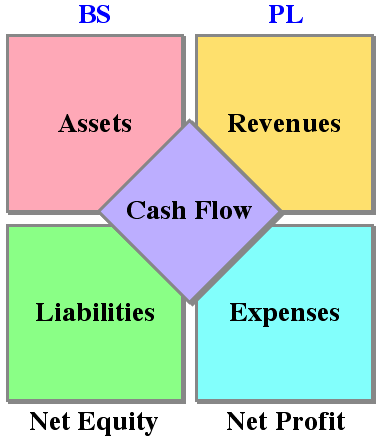 reflects the value created
or destroyed by transactions. But in the New Economy, value can
be created or destroyed without any transactions with third parties. reflects the value created
or destroyed by transactions. But in the New Economy, value can
be created or destroyed without any transactions with third parties.
- Assets are both tangible and intangible.
- Assets are defined more broadly as sources of future value.
- Assets are both owned and unowned, controlled and not.
- Assets in each category produce outputs.
- Assets have distinct life cycles.
- Assets must be managed to create, rather than destroy, value.
- Assets include internal and external sources of value.
- Value Dynamics creates a common language of value.
- Physical Assets:
- Land
- Buildings
- Equipment
- Inventory
- Financial Assets:
- Cash
- Receivables
- Debt
- Investment
- Equity
- Employee and Supplier Asset:
- Employees
- Suppliers
- Partners
- Customer Asset:
- Customers
- Channels
- Affiliates
- Who is crating value with which asset?
- Physical assets: The Williams Companies, Inc.
- Financial assets: The General Electric Company
- Employee and Supplier assets: Starbucks Corporation
- Customer assets: The Charles Schwarb Corporation
- Organization assets: idealab!
|
1.
バリュー・ダイナミクス・フレームワーク:
 - 500年に亘り使用されている会計手法は、取引で増減する価値を反映する。しかし、ニューエコノミーでは、第三者との取引の有無に関係無く価値が増減する可能性がある。
- 資産には有形資産と無形資産とがある。
- 資産には将来の価値を含め、もっと広く定義される。
- 資産は、所有しているだけでなく非所有も、また管理されているだけでなく管理されていないものも含む。
- 資産の各項目はアウトプットを生み出す。
- 資産には明確なライフサイクルがある。
- 資産は価値を創造するために管理されるべきであって、その価値を低下されるためではない。
- 資産は、内部にも外部にも価値の源泉を含む。
- バリュー・ダイナミックスは価値の共通語を作り出す。
- 物的資産:
- 金融資産:
- 従業員・サプライヤ資産:
- 顧客資産:
- それぞれの資産で価値創出している企業:
- 物的資産:ウィリアムズ(WMB)
- 金融資産:GE
- 従業員サプライヤ資産:スターバックス(SBUX)
- 顧客資産:チャールズシュワブ(SCH)
- 組織資産:アイデアラボ (Idea Labo)
|
>Top 2. Physical Asset:
- "Sooner or later, you need more than an outpost in cyberspace.
When you have a problem affecting customers, that's when you know
the true meaning of the word 'mortar.' It's a false dichotomy
to think you're either doing business online or you're doing it
in the old-fashioned way. We're all embedded in the real world. (David
S. Pottruck - Charles Schwarb)
- Physical assets are measured and accounted for on the balance
sheet. Book value, tough, is often not a good guide to the market
value of these assets. And it doesn't show whether they create
value for a business or detract from its overall worth.
- How do we define land?
- A piece of real estate held for productive use or investment.
We also include land improvements. Raw land without roads,
utility connections, and the like is worthless in most business
situations.
- How do we define a building?
- Any tangible structure that most often is permanently
attached to the land on which it sits and is usable for human
habitation.
- How do we define equipment?
- A machine or tool employed to complete a particular task.
- It includes computer hardware and other digital-age equipment.
But we don't classify the codified knowledge embedded in computer
software and systems as equipment. It is an organization asset.
- How do we define inventory?
- Items of tangible property that are held for sale in the ordinary
course of business, are used in the process of production, or
are to be consumed to produce products or services. Inventory
include finished goods, partly finished goods, or work in process.
- It also includes raw materials that become part of a company's
product, and supplies used in the normal course of a company's
operations.
|
2. 物的資産とは何か:
- 遅かれ早かれ、サイバースペース上には前哨基地以上のものが必要となってくる。顧客に影響を及ぼす問題が生じて初めて、「モルタル」の意味がわかるようになる。オンラインでや従来通りにリアルにビジネスするかというような二分法的な考えには間違いである。なぜなら我々はすべて現実世界の中に組み込まれているからだ。(David
S. Pottruck - Charles Schwarb)
- 物的資産は貸借対照表に計上されるが、簿価による資産価値表示は、時価を示す指標としては不適切である。また資産がビジネスの価値を生み出しているのか、逆に全体的な価値を減らしているのかについても明確でない。
- 土地とは何か:
- 生産活動または投資のために所有される不動産と定義する。ただし土地開発を含む。道路などインフラがなければほとんどの土地はビジネスに適しないから。
- 建物とは何か:
- 土地の上に恒常的に建設され、住居として使用可能な有形構造物
- 設備とは何か:
- 特定の作業を行うために使用される機械または道具。
- なお、コンピュータやその他デジタル時代に必要な設備を含む。但し、ソフトウェアやシステムに組み込まれた開発技法や言語に関する知識は設備ではなく、組織資産に含まれる。
- 在庫とは何か:
- 業務上の販売を目的ととして保有され、製造工程、商品・サービスの生産過程で使用される物的資産。在庫には完成品、半完成品、仕掛品が含まれる。
- また企業の製品の一部となる原材料や、通常の業務で使用される供給物品も対象となる。
|
>Top 3. Financial Assets:
- How do we define cash?
- Currency on hand. We also include demand deposits with banks
or other financial institutions.
- Companies invest idle cash in highly liquid short-term investments
like money market funds and US Treasury bills. These are known
as cash equivalents.
- How do we define cash flow?
- the amount left over after providing working capital to the
company's businesses, making investments, and paying dividends
and interest.
- How do we define receivables?
- claims a business expects to collect form its customers and
others, usually arising from the sale of goods, provision of
services, or advancement of funds.
- the amount recorded on the balance sheet also reflects a
sum set aside for doubtful accounts that probably won't be collected.
- How do we define investment?
- common stocks, bonds, and other financial instruments.
- Like an individual investor, a company puts its money into
the securities of another company or joint venture because it
sees the promise of making even more money.
- How do we define debt?
- There are many sources of debt: bonds and term loans that
a company uses to obtain capital - and create value.
- How do we define equity?
- an ownership interest in the residual assets of an entity
that remain after liabilities are deducted. Equity isn't an
asset. However, just as with debt, we define the ability to
raise equity by issuing stock as a key asset.
- The role of equity is fundamental to risk management.
- Risk and opportunity are inseparable. In a world with no
risk or uncertainty, little equity is required.
- The equity markets allow them to spread risk over many investors
and generate a form of currency (stock) to be used for growth.
|
3.
金融資産:
- 現金とは何か
- 現金とは手元資金のことである。銀行その他の金融機関の要求払預金など。
- 会社は遊休資金を、現金運用ファンドや米国国際など短期で流動性の高い金融商品へ投資しており、これらは短期金融商品と呼ばれる。
- キャッシュフロー:
- 投資、配当支払、金利支払いに当てた後の運転資金の剰余金
- 売掛金とは何か:
- 売掛金とは、商品の販売やサービスの提供、資金の前貸しなどにより、顧客その他からの回収が期待ができる支払請求金である。
- なお、BS上の金額には、回収不能が起こるような要注意顧客に対応するための準備金を積み立てる。
- 投資とは何か:
- 投資とは、株式投資、債券投資、その他金融証書への投資。
- 個人投資家同様に、企業もさらなる大きな利益獲得を狙って、他社の株式やJ/Vに投資する。
- 債務とは何か:
- 債務とは第三者からの借入金で、さまざまな形態がある。債権や短期資金など企業が資金調達に利用し、価値を生み出すような債務証券である。
- 資本とは何か:
- 負債の差引後に残る企業の純資産
- 資本は資産ではない。しかし、債務同様、株式発行によって資本調達できる能力は重要な資産である。
- 資本の役割はリスク管理にとって本質的である。
- リスクと機会は切り離すことはできない。もしリスクや不確実性のない世界なら、資本はほとんど必要としなくなる。
- 株式市場はリスクを多数の投資家に分散し、成長のために使用する資金 (株式)を発行している。
|
>Top 4. Employee and
Supplier Assets:
- "People are innately curious and, as social animals, are naturally
motivated to interact and learn from one another." (Sumantra
Ghoshal and Christopher Bartlett)
- How do we define an employee?
- People aren't a line item. But they are assets. specifically,
they are employee assets (sometimes referred to as human capital.)
- The value of employee assets lies in their skills, knowledge,
experience, and attitudes and is enhanced by an organization's
ability to hire, train, motivate, and retain the best people.
- How do we define a supplier?
- anyone who furnishes materials, products, or services.
- Clearly companies are dependent upon their suppliers, as well
as their suppliers' suppliers, and so on down the line. Identifying
different supplier assets can pave the way for creating value
or become the lifesaver that keeps value from disappearing.
- How do we define a partner?
- parties associated as joint principals in a business venture
- Joint venture are contractual arrangements in which two or more
partners undertake economic activity that is subject to joint
control.
|
4. 従業員・供給者資産:
- 人は生来好奇心があり、社会的動物として相互に関係し、学び合うことに興味を持っている。 (Sumantra Ghoshal
and Christopher Bartlett)
- 従業員とは何か:
- 従業員は在庫ではない。彼らは従業員資産(人的資産と呼ばれる)に該当する。
- 従業員資産の価値は、その技術、知識、経験および姿勢にある。またその価値は、採用・教育研修・モチベーションを与え、最高の人材を維持する組織の能力によって高められる。
- サプライヤとは何か:
- サプライヤとは、原材料、商品またはサービスの供給者である。
- 企業は、直接のサプライヤ、そしてサプライヤのサプライヤ、さらにその末端にまで依存している。それぞれのサプライヤ資産の特定することによって、価値創出へとつながっていき、あるいは価値の消滅するのを防ぐ命綱となり得るのである。
- パートナーとは何か:
- パートナーとは、ビジネス発展のためにために、提携した当事者である。
- J/Vとは、2つ以上のパートナーが共同の管理下で経済活動を行う契約関係のこと。
|
>Top 5. Customer Assets:
- "Customers do not want more choice. They want exactly what they
want - when, where, and how they want it." (B. Joseph Pine II,
etc.)
- How do we define a customer?
- The buyers of a product or service.
- "We exist to provide value to our customers. ... Nothing
happens until a customer walks into a store with a purpose,
buys something, and walks out." (Samuel Moore Walton)
- "It's not management who decides how many people are on
the payroll. It's customers. ... Without a growing roster
of satisfied customers, we call all turn out the lights and
go home." (Lawrence A. Bossidy)
- How do we define a channel?
- A channel is critical to moving merchandise or services
from a supplier to a consumer or end user.
- The Internet is a channel par excellence. Channels can enable
salability and enhance all the other assets in portfolio.
- How do we define an affiliate?
- A closely associated organizations. "A close collaboration,"
the alliance partners share information and customers.
|
5.
顧客資産:
- 「顧客は多くの選択肢を求めているのではない。顧客は、真に欲しいものを、欲しいときに、欲しい場所で、欲しいと思う方法で手に入れたいと望む。」 (B.
Joseph Pine II, etc.)
- 顧客とは何か:
- 顧客とは、商品やサービスの購入者である。
- 「会社は顧客に価値を提供するために存在している。顧客がある目的をもって来店し、何かを購入しない限り、何も起こらない。」(Samuel
Moore Walton)
- 「従業員数を決定するのは経営陣ではない。顧客である。満足している顧客数が増加しない限り、我々は皆、消灯して帰宅するしかない。」(Samuel
Moore Walton)
- チャネルとは何か:
- 流通チャネルは、サプライヤから消費者もしくはエンドユーザへの商品やサービスを販売するために極めて重要である。
- インターネットは偉大なチャネルであり、柔軟性をもたらし、ポートフォリオ上のすべての資産を強化できる特性を有している。
- 関連会社とは何か:
- 密接な関係にある企業。提携パートナーとの間でさまざまな情報と顧客の共有が可能となっている。
|
>Top 6. Organization
Assets:
- "The range of new economic combinations is immense and the choice
of one rather than another is, in the last analysis, an exercise
in human, or entrepreneurial, judgment." (R.H. Campbel)
- How do we define leadership?
- You won't find leadership listed
among the assets. Value Dynamics includes leadership in an
asset category we call organization.
- Leadership is the capacity to inspire, organize, lead,
and manage the value-creation process.
- Organization Assets include strategy, structure, culture
and values, processes, systems, the capacity to innovate,
brands, and proprietary knowledge.
- How do we define structure?
- Being able to visualize the structure of a organization is
a useful tool for understanding how it works. And structural
understanding can spark value creation.
- "Conventional thinking says that as you get bigger, you have
to slow down. ... But we have a formula for sustaining growth,
and the formula is our structure." (Ralph S. Larsen)
- How do we define processes?
- They are the series of operations, methods, actions, tasks,
or functions leading to the creation of an end product or service.
- "We knew that companies could dramatically improve their
efficiency and quality by focusing on customers and the processes
that create value for them. But we didn't realize that companies'
processes would come to be even more important than their
products. We started out thinking that if we could improve
their processes, we could help them compete better in their
chosen markets. And now it turns out that processes are, in
fact, determining the markets in which the companies compete."(Michael
Hammer)
- How do we define a system?
- An information system might be likened to the body's central
nervous system, for example, transmitting message and important
pieces of information throughout the enterprise.
- When we speak of systems, we don't mean hardware. Rather,
we are referring to the codified knowledge that assembles,
organizes, and directs the flow of information.
- How do we define culture and values?
- Values are an organization's guiding principles or minimum
negotiable standards of behavior. They help employees to
make sound decisions without the need for constant cross-checking
and bureaucracy.
- How do we define a brand?
- Brand is your reputation, as the result of the interaction
of your employees with customers and suppliers, as the external
manifestation of our strategy and culture.
- How do we define proprietary knowledge?
- It is any concept, idea, invention, literary creation, software
program, or other artistic or creative work that is definable,
measurable, and exclusive in nature.
- What matters to create value: four realities of the New Economy.
- New business models are merging, based on unique combination
of assets, including technologies. Businesses are their assets
- all of their assets, tangible and intangible.
- New business models create new risks. But risk in the New
Economy encompasses upside opportunity as well as downside
threat.
- New processes and tools are needed to manage both new business
models and new risks. How a company builds and manage in unique
portfolio of asset is what drives economic success.
- Transparency of information is vital to value creation in
the New Economy. But decision makers need better access to
information than what they are getting today.
|
6. 組織資産:
- 「ニューエコノミーの組合せは非常に多様で、どれを選択するかは、最終的には、人、つまり起業家としての判断に依る。」 (R.H.
Campbel)
- リーダーシップとは何か:
- リーダーシップは、資産項目としては含まれない。
バリューダイナミックスではリーダーショップを組織資産という項目に含めている。
- リーダーシップとは、価値創造の過程を示し、組織を立ち上げ、これを指導かつ管理できる能力である。
- 組織資産とは、戦略、組織構造、文化、価値、プロセス、システム、革新性、ブランド、および知的資産を含む。
- 組織構造とは何か:
- 組織構造を視覚化できることで、その機能理解を助ける道具として有効であり、さらに組織に対する理解が価値の創造を導くことに通じる。
- 「 従来の考えでは、組織が大きくなればなるほど、動きが鈍化する。しかし我々は成長を維持する方式をもっている。それは我々の組織構造である。」 (R.H.
Campbel)
- プロセスとは何か:
- プロセスとは、最終製品やサービスを創造することにつながる一連の運営、方法、行為、役割、および機能である。
- 「我々は、企業が顧客および顧客の価値を生み出すプロセスに集中することによって、効率と品質を大幅に改善できることを知っていた。しかし、企業のプロセスが、企業が生み出す商品よりも重要になるとは認識していなかった。もしプロセスを改善すれば、自ら選択した市場でさらに競争力を高めることができると認識するに至った。今や、プロセス自体が、企業が競争する市場を決定するようになってきている。」 (Michael
Hammer)
- システムとは何か:
- 情報システムは人体の神経システムに似ている。それはメッセージや重要な情報断片を組織中に伝達するからである、
- システムとは、ハードウェアに限らない。情報を収集し、組織し、その流れを決めるコード化された知識をいう。
- 文化と価値とは何か:
- 価値とは、組織の基本原則、あるいは受入可能な最小の行為基準である。これによって、いつも相互確認したり、官僚的にならずに、健全な意志決定ができるようになるのである。
- ブランドとは何か:
- ブランドとは企業の評判であって、従業員と顧客やサプライヤとの関係の結果であり、戦略や企業文化の対外的な発現である。
- 独自の知識とは何か:
- あらゆる定義可能で、計測可能かつ排他的であるような概念、アイデア、発明、文章、ソフトウェアプログラム、またはその他の芸術的・創造的作品のことである。
- 価値創造に不可欠な4要素:
- 新たなビジネスモデルは、テクノロジーを含むユニークな有形無形の資産の組合せから生まれる。
- 新たなビジネスモデルは新たなリスクを生む。但しニューエコノミーにおけるリスクには 機会と脅威とがある。
- 新しいプロセスとツールが新たなビジネスモデルとリスクの管理には必要となる。企業にとってはいかにユニークな資産ポルトフォリオを確立し管理するかが成功への鍵である。
- 情報の透明性はニューエコノミーにおける価値創造には必須となる。特に意志決定者は今日以上に優れた情報アクセスが必要となる。
|
>Top 7.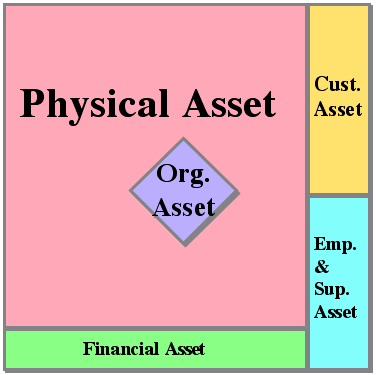 Value images
- the old and new economy: Value images
- the old and new economy:
- "If you want to do something new, you have to stop doing something
old." (Peter Drucker)
- Your organization needs to have a coherent, integrated approach
to the four challenges of value creation in this new century:
- Design your business model for value creation.
- Master risk in an uncertain environment.
- Manage your business as a portfolio of assets.
- Use information, measure and report all our assets.
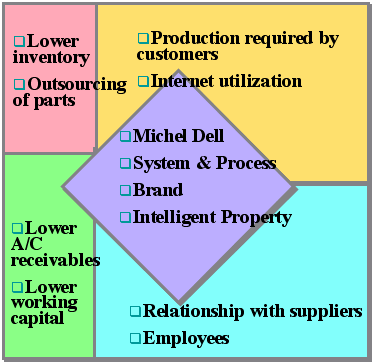 |
7. 新旧エコノミーのバリューイメージ:
- 「何か新しいことを始めたいと思うなら、古いことをやめなければならない。」 (Peter Drucker)
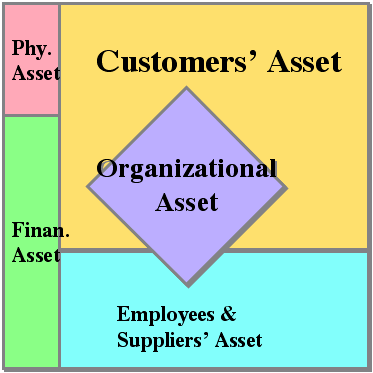
- 企業の総括的な課題:
- 価値創造のためのビジネスモデルの設計
- 不確実な環境におけるリスクの計算
- 資産ポートフォリオ管理としてのビジネス管理
- 情報活用によるすべての資産内容の定量化と報告
|
>Top 8. Master Risk:
- "The revolutionary idea that defines the boundary between
modern times and the past is the mastery of risk." (Peter.
L. Berstain "Against the
Gods" )
- We are all paid to take risks. (Lawrence A. Bossidy)
- Companies that respond proactively to the new business realities
are likely to have a much better understanding of the risks
they are taking than those companies that choose to do nothing
in the mistaken belief they are avoiding risk.
- Business risk model:
- Environmental Risk:
Uncertainties affecting the viability of your business model.
- Process Risk:
Uncertainties affecting the execution of your business model.
- Information for Decision Making Risk:
Uncertainties over the relevance and reliability of information
that supports your decisions
- How do you become a master of risk?
- Companies need to learn how their investments in assets create
exposures to both an upside and a downside. Intangible sources
of value are often the greatest source of risk.
- Options for managing risks:
- Risk avoidance:
The options include divesting of businesses and prohibiting
or restricting specific activities.
- Risk retention:
results in accepting risk at its present level.
- Risk reduction strategies:
reduce the severity of the risk and/or its likelihood of occurrence.
- Risk transfer options:
incorporate the use of hedging and insurance to provide a form
of contingent capital.
- Risk exploitation strategies:
are used to enter new markets, introduce new products, merge
with or acquire another firm or exploit other market opportunities,
all of which reshape a company's risk profile.
- When taking on risks to exploit market opportunities, each
company has areas where it excels relative to its competitors.
|
8. リスクの見極め:
- 「現代と過去の境界を定める革命的なアイデアはリスクの克服である。」 (Peter. L. Berstain "Against the Gods" )
- 「我々はリスクを負うことで、給与を受け取っている。」 (Lawrence A. Bossidy)
- 新しいビジネスの現実に対して、積極的に応じている企業の方が、何も行わずにいることでリスクを防いでいると錯覚している企業と比較して、自ら許容できるリスクについて深く理解している可能性が高い。
- ビジネスリスクモデル:
- 経営環境リスク:
ビジネスモデルの有効性に影響する不確実性
- プロセスリスク:
ビジネスモデルの実行に影響する不確実性
- 意志決定のための情報リスク:
意志決定をさせる情報の妥当性と正確性に関する不確実性
- リスクをいかに克服すべきか:
- 企業は、資産への投資にはプラス面とマイナス面の可能性をまず理解しなければならない。特に無形の資産が最大のリスク源となることがしばしばある。
- リスク管理上の選択肢:
- リスク防止:
選択肢としては、ビジネスそのものの中止、撤退、特定活動の中止または制限。
- リスク許容:
現在のレベルでのリスクを許容する。
- リスク軽減戦略:
リスクの重症度とその発生可能性を少なくする。
- リスク移転:
ヘッジや保険といった手段で見返りの偶発資本を得る。
- リスク利用:
新規市場参入や新商品導入、他社との合併買収など企業の多様化、拡大、選択と集中などでリスクを活かす。
- 市場機会利用:
他社との比較優位な分野に着目する。
|
>Top 9. Manage Asset
Portfolio:
- "Insistently, persistently, relentlessly, the new manager
must ask, "What for?" What is it that we're in business
for? What is this process for? This product? This task? This team?
This job; What are we doing here, anyway?"(James Champy)
- Assets have life cycles:
- Fix assets:
The virtual portal to the consumer created a new kind of extra-physical
location for bringing businesses and customers together.
- Technologies:
One miracle was superseded by another, renewing the value of
some assets and making others redundant.
- Employees:
The reality is that new technologies have accelerated the pace
of hiring, training, and losing employees.
- Customers:
Today, customers are in the drivers's seat. Information technology
advances have made them such better informed of their choices
and less likely to settle for he second best. Customer loyalty
has diminished.
- Business models:
Some management groups didn't know where the real value was
being created along that supply chain. Then deregulation comes,
and the value chain begins to fragment.
|
9. 資産ポートフォリオ管理:
- 「新たな管理者は、熱心に、いつも、そして執拗に、何のためかを問いかけねばならない。なぜその仕事を行うのか。何のためのプロセスか。この製品、この仕事、このチームはどうなのか。我々は結局ここで何をしているのかと。」(James
Champy)
- 資産にはライフサイクルがある。
- 固定資産:
インターネット・ポータルの登場は、企業の消費者が集まる新しいバーチャルな場を形成した。
- テクノロジー:
かつての技術革新は次世代の技術革新にとって代わられる。それにより一部の資産価値は更新され、その他は余剰資産となってしまう。
- 従業員:
新しいテクノロジーの出現が、従業員の採用、教育や訓練、離職、喪失のペースを速めている。
- 顧客:
現在は買い手市場。情報技術の進歩が顧客に選択肢に関する情報を大量にもたらし、中途半端な技術や品質で顧客が満足する可能性が低くなっている。顧客のロイヤリティは収縮している。
- ビジネスモデル:
経営者はサプライチェーンのどこで本当の価値が創出されているか理解していない。一端規制緩和されるとバリューチェーンは瓦解し始める。
|
>Top 10. Measure and
report all assets:
- "The next information revolution ... largely underlies the
new definition of the function of business enterprise as the 'creation
of value and wealth.'" (Peter Drucker)
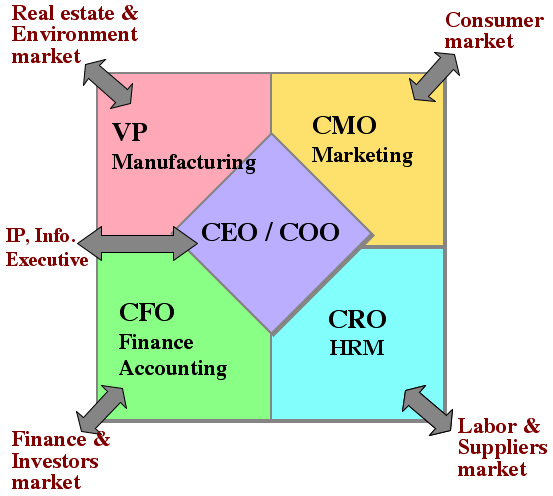 Our prophecy: Our prophecy:
In the New Economy, companies will need to continuously measure
and report all assets at fair value to all users.- Information transparencies emerge:
- Physical Markets: eSteel.com
- Employee Markets: Monster.com, Monster Talent.com
- Customer Markets: Compare Net, C2B technologies
- Financial Markets: global capital market
- Organization Markets: new market makers targeting
transactions in IP, Patentauction.com
- Every company is an information company at heart.
- Reporting continuum:
- Internal, Employee & Suppliers, Partners, Customers, Financial
press, Creditor, Investors, Public
|
10. 全ての資産の評価と報告:
- 次の情報革命は、企業の機能を「価値と富の創造」として新たに定義し直すことになる。(Peter Drucker)
- 予言:
ニューエコノミーでは、企業は全利用者に適正な価値判断に基づき継続的に全資産を評価報告しなければならなくなる。
- 情報の透明性の出現:
- 物的市場:
- 従業員市場:
- Monster.com
- MonsterTalent.com
- 顧客市場:
- Compare Net
- C2B technologies
- 金融市場:
- 組織市場:
- あらゆる企業は本質的には情報企業
- 継続的な報告:
- 内部
- 従業員/サプライヤ
- パートナー
- 顧客
- 広報
- 債権者
- 法定報告者
- 一般
|
>Top 11.
Example Stock, Flow and Effectiveness KPI's:
Asset category |
Stock |
Flow |
Effectiveness |
Financial |
・Investment value
・Cash on hand
・Debt-Equity ratio |
・Free cash flow
・Days of receivables |
・Return on investment
・Cash flow per employee |
Physical |
・Inventory on hand
・Fixed asset investment
・Square feet office space |
・Inventory turnover
・Depreciation
・Growth in office space |
・Inventory carrying cost
・Return on assets; machine utilization
・Occupancy |
Customer |
・Number of customers
・Market share |
・Customer churn |
・Customer satisfaction
・Revenue per customer |
Employee & Supplier |
・Number of employees
・Number of suppliers |
・Employee turnover/retention
・Number of suppliers meeting strategic criteria |
・Revenue per employee
・Procurement cost
・Ability to recruit employees and change suppliers
・Employee understanding of strategy |
Organization |
・Number of patents |
・R&D expenditures
・Succession plan |
・Licensing income as % of R&D
・Successful business strategy
・Revenue from products <3 years |
|
例:在庫、フロー、効果:
資産 |
在庫 |
フロー |
効果 |
金融資産 |
・投資価格
・現金
・負債資本比率(D/E) |
・フリー・キャッシュフロー
・売掛金回収日数 |
・投資利益率
・従業員当たりキャッシュフロー |
物的資産 |
・実在庫
・固定資産投資
・事務所面積 |
・在庫回転率
・減価償却
・事務所面積拡張 |
・在庫保有費用
・総資産利益率; 機械稼働率
・不動産稼働率 |
顧客資産 |
・顧客数
・市場シェア |
・顧客解約率 |
・顧客満足度
・顧客当たり売上高 |
従業員、供給者資産 |
・従業員数
・供給者数 |
・従業員回転率
・戦略的供給者数 |
・従業員当たり売上率
・調達コスト
・従業員採用、供給者変更能力
・従業員の戦略理解 |
組織資産 |
・保有特許数 |
・研究開発費用
・継承計画 |
・研究開発対ライセンス収入比率
・成功した事業戦略
・商品開発後3年以内の収入 |
|
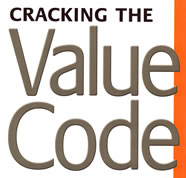

 reflects the value created
or destroyed by transactions. But in the New Economy, value can
be created or destroyed without any transactions with third parties.
reflects the value created
or destroyed by transactions. But in the New Economy, value can
be created or destroyed without any transactions with third parties.

 Value images
- the old and new economy:
Value images
- the old and new economy: 

 Our prophecy:
Our prophecy: